Catocala ultronia
Catocala ultronia
kah-TOCK-uh-lahmmul-TROH-nee-uh
(Hubner, 1823)
Eunetis ultronia
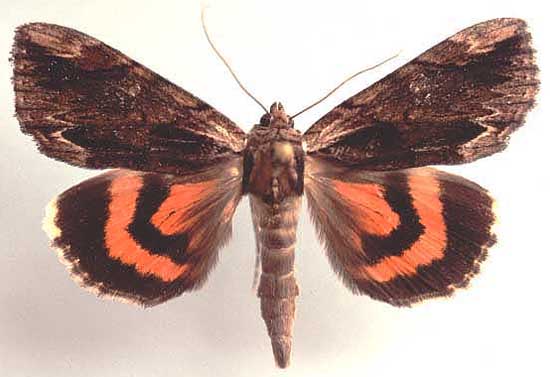
Catocala ultronia, courtesy of James Adams.
This site has been created by
Bill Oehlke at oehlkew@islandtelecom.com
Comments, suggestions and/or additional information are welcomed by Bill.
| TAXONOMY:
Superfamily: Noctuoidea
Family: Noctuidae
Group: Noctuinina
Subfamily: Catocalinae
Genus: Catocala, Schrank, 1802
species: 8857 ultronia
| |
MIDI MUSIC
"Moon River"
copyright C. Odenkirk
MIDI CITYON.OFF
<bgsound src="moon.mid" LOOP=FOREVER>
|
DISTRIBUTION:
In the United States, it has also been reported in
Arkansas,
Colorado,
Delaware,
District of Columbia,
Georgia,
Idaho,
Illinois,
Indiana,
Iowa,
Kansas,
Kentucky,
Louisiana,
Maryland,
Massachusetts,
Mississippi,
Missouri,
Montana,
Nebraska,
New Jersey,
New Mexico,
New York,
North Carolina,
North Dakota,
Ohio,
Pennsylvania,
Rhode Island,
South Carolina,
South Dakota,
Vermont,
Virginia,
West Virginia,
Wisconsin and
Wyoming.
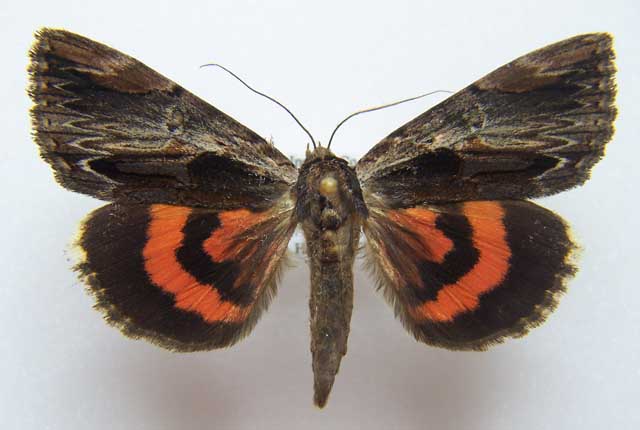
Catocala ultroni form celia, bait, Mason, Ingham County, Michigan,
July 7, 1994. courtesy of Harry King.
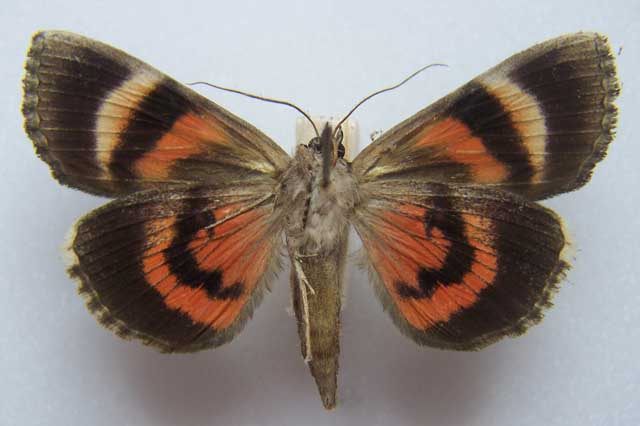
Catocala ultroni form celia (verso), bait, Mason, Ingham County, Michigan,
July 7, 1994. courtesy of Harry King.
Occasionally the lower wings will be yellow instead of orange.
There is considerable variation in forewing pattern as shown in this
specimen from Ontario, courtesy of Lynn Scott, the specimen from
Marion County, Florida, courtesy of Leroy Simon and in the three
specimens courtesy of Vernon A. Brou at botom.
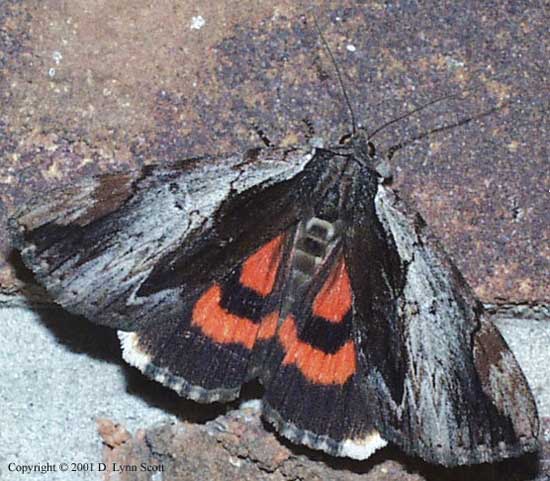
Catocala ultronia courtesy of Lynn Scott
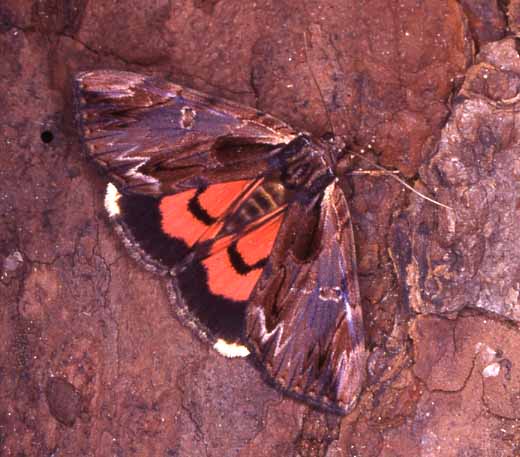
Catocala ultronia courtesy of Leroy Simon
The forewings are typically gray-brown, with a dark lower margin and
a characteristic brown patch near the wingtip.
The hind tarsi have three rows of spines. The outer wing margin
(lower wings) is heavily barred with a pure white patch at the apex.
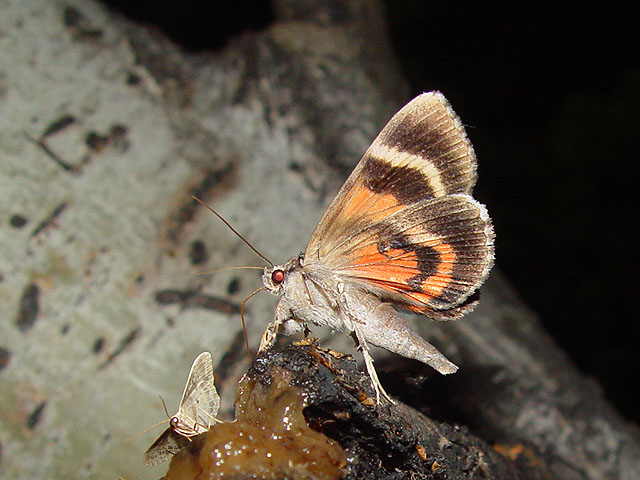
Catocala ultronia, Peterborough, Ontario, July 22, courtesy of
Tim Dyson.
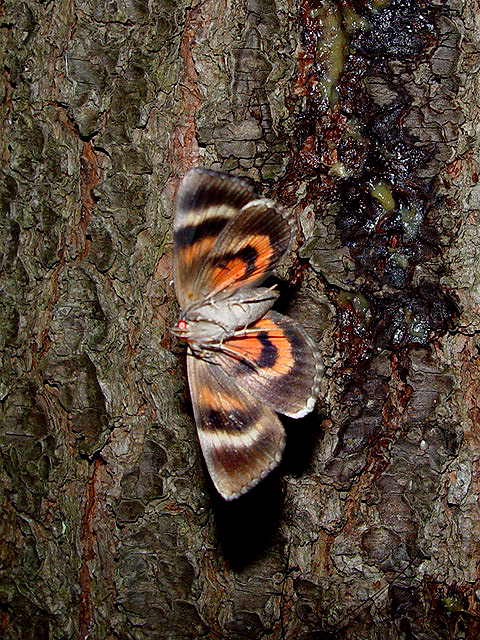
Catocala ultronia undersides, Peterborough, Ontario,
July 27, 2006 courtesy of
Tim Dyson.
I have listed the following Catocala ultronia sightings in chronological order by month and day, not by year, to provide a generalized
idea of when to expect flights in different parts of the country. A quick analysis shows that flights can start as early as April in Texas, June in Georgia and
Tennessee, July in Pennsylvania, New York and Saskatchewan, August in Maine, Michigan and New Hampshire.
The egg is the overwintering stage. As soon as temperatures warm and host plant leaves burst forth, larvae can hatch from eggs and begin feeding. Mature larvae
spin flimsy cocoons, pupate inside them, and then usually emerge as moths in about three to four weeks. Hence there are earlier spring flights in southern regions
and later flights in northern regions. Cooler or warmer weather from year to year can influence development and emergence times, and these moths
can live for at least several weeks, replenishing energy from flower nectar, fermenting tree sap, fermenting fruit.
All species in this genus are thought to be single brooded.
Catocala ultronia Concan, Uvalde County, Texas, late April.
Visit Catocala ultronia, Pickens County, Georgia, June 20, 2009, Aubrey Scott.
Visit Catocala ultronia, Montgomery County, Tennessee, June 30, 2008, Tom Payne Tennessee Catocala Collection.
Catocala ultronia, Floyd Bennet Field, Jamaica Bay area, New York City Metropolitan Area, July 6, Steve Walter
Visit Catocala ultronia, form celia, Forest Hills, Allegheny County, Pennsylvania, July 15, 1998, Curt Lehman
Visit Catocala ultronia, male, 55mm. Lumsden, Saskatchewan, July 25, 2010, Tim Taylor.
Visit Catocala ultronia forms celia and lucinda, Peterborough, Ontario, August 1, 2016, Tim Dyson
Visit Catocala ultronia form celia, Sidney, Kennebec County, Maine, August 4, 2011, Steve Lemieux
Visit Catocala ultronia, Ogemaw County, Michigan, August 12, 2011, Cindy Mead.
Catocala ultronia, Peterborough, Ontario, July 27, August 14-17, 2004, courtesy of Tim Dyson
Visit Catocala ultronia form lucinda, Amherst, Hampshire Co., Massachusetts, Sept. 3, 2011, Joshua S. Rose.
Catocala ultronia, Rockingham County, New Hampshire, August 4 - September 22, Deb Lievens.
Visit Catocala ultronia, Athol, Worcester County, Massachusetts, Sept. 28, 2011, Dave Small.
FLIGHT TIMES AND PREFERRED FOOD PLANTS:
In Quebec and Ontario
Catocala ultronia flies from early July to late September.
Deb Lievens reports Catocala ultronia on the wing in Rockingham County, New Hampshire, from
August 4 - September 22.
In Concan, Texas, moths have been taken in late April.
Tim Dyson of Ontario, Canada, sent me this nice image copyright of an apparent
Catocala "fan". Tim has been using some red wine in his bait
(August 14), but "me thinks" the "frog" is happy for other reasons.
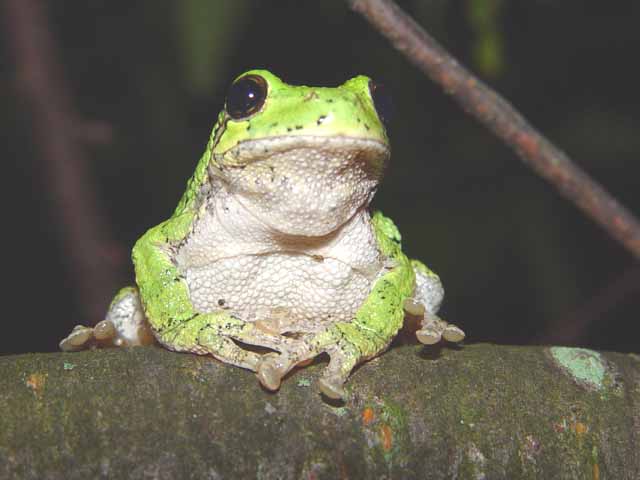
Moths come in to lights readily and also to bait.
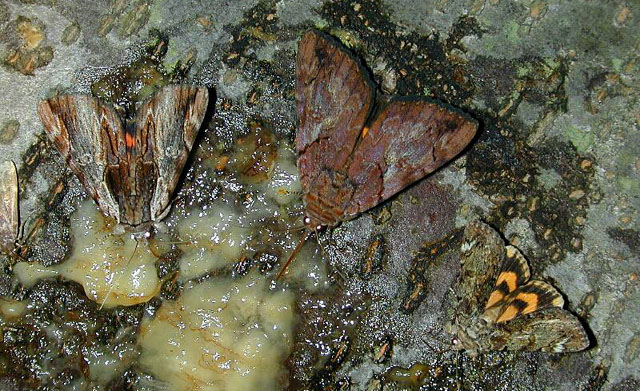
Catocala ultronia, Catocala muliercula and Catocala minuta
on fermenting tree sap
courtesy of Steve Walter, Floyd Bennet Field
(Jamaica Bay area of New York) July 6.
Steve writes, "The Little Wife is one of the signature species of
Jamaica Bay -- but this one was 11 days (seems to be a magic number,
or times 2) earlier than the previous early date here. The Little
Underwing was new for Jamaica Bay -- and I had 6 of them. Funny how
that happens."
The Catocala ultronia caterpillar shows a preference for
members of the Rosaceae family: Malus (apple),
Prunus pensylvanica (pin cherry),
Prunus serotina (wild black cherry), Prunus virginiana
(choke cherry), Fraxinus pennsylvanica (green ash),
Tilia americana (American basswood, American linden)
and Populus grandidentata (Big Tooth Aspen).
ECLOSION:Adults eclose from pupae amongst
ground litter or near the soil surface.Usually when adults alight
on a vertical surface, they align themselves with bodies vertical (ultronia rest with head down).
I wonder if this specimen is trying to take advantage of the
horizontal grey mortar line. Image courtesy of Lynn Scott.
| 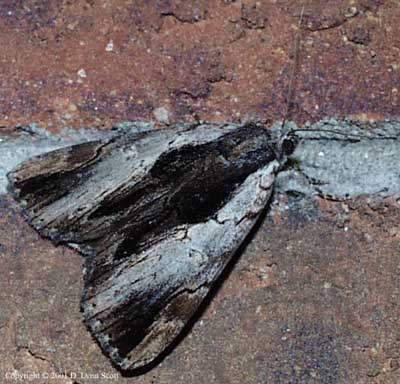 |
SCENTING AND MATING:
Catocala ultronia females emit an airbourne pheromone and males use their antennae to track the scent plume.
EGGS, CATERPILLARS, COCOONS, AND PUPAE:
Grey, cushion shaped, sculptured eggs are deposited on tree bark in the fall and hatch the following spring.
Note the prominent horn on the fifth abdominal segment.
There is a distinct black line on top of head and an oblique black line running (anterior) from base of the slightly enlarged dorsal
scoli of eight abdominal segment. Dense and relatively long fringe and body are grey. Image courtesy of David Wagner. |
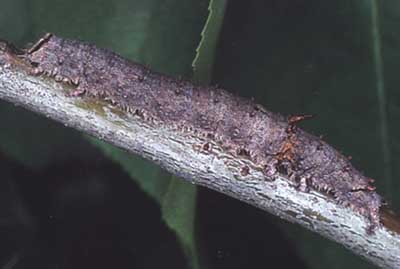 |
Larval Food Plants
Listed below are primary food plant(s) and alternate food plants. It is hoped that this alphabetical listing followed by the common
name of the foodplant will prove useful. The list is not exhaustive, although some species seem very host specific.
Experimenting with closely related foodplants is worthwhile.
Fraxinus pennsylvanica.....
Malus
Populus grandidenta
Prunus pensylvanica
Prunus serotina
Prunus virginiana
Tilia americana
|
Green ash
Apple
Big Tooth Aspen
Pin cherry
Wild black cherry
Choke cherry
American basswood, American linden
|
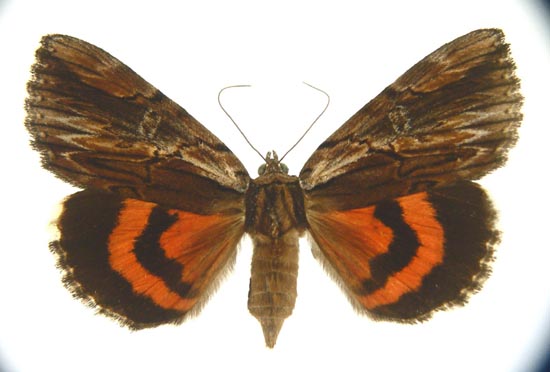
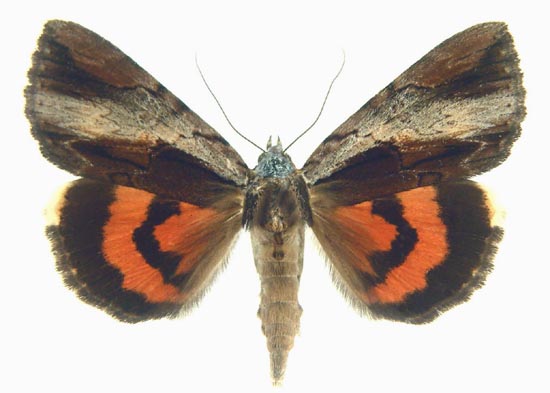
Catocala ultronia form celia, courtesy of Vernon Brou.
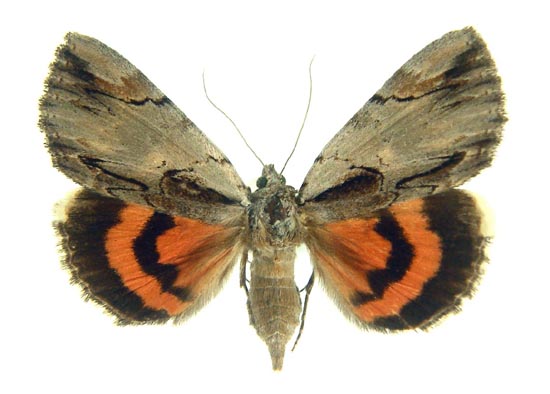
Catocala ultronia form lucinda, courtesy of Vernon Brou.
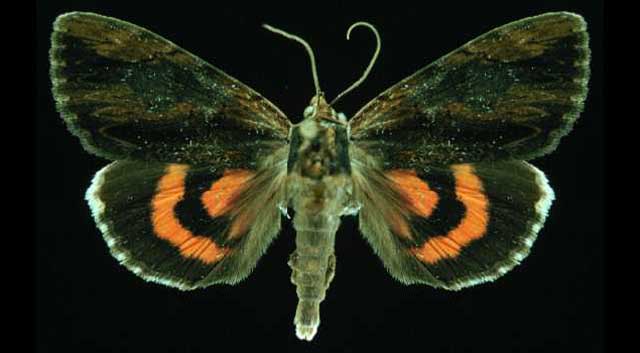
Catocala ultronia form nigrescens, Harold J. Vermes slide, permission from his son;
"Leverett, Franklin Co., MA (taken on 28 July 1971)", Theodore Sargent.
There is also a melanic form known as mopsa. I think "mopsa" may be the same as "lucinda".
Use your browser "Back button to return to the previous page.
Goto Main Catocala Index
This page is brought to you by Bill Oehlke and the
WLSS. Pages are on space rented from Bizland. If you would like to become a "Patron of the Sphingidae/Catocala Sites",
contact Bill.
Please send sightings/images to Bill. I will do my best to respond to requests for identification help.
Enjoy one of nature's wonderments: Live Saturniidae (Giant Silkmoth) cocoons.

|

To show appreciation for this site, click on the flashing
butterfly to the left, a link to many worldwide insect sites. |
















